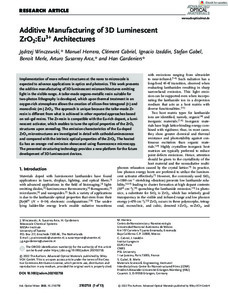| dc.date.accessioned | 2023-07-28T16:01:52Z | |
| dc.date.available | 2023-07-28T16:01:52Z | |
| dc.date.issued | 2022-04-27 | |
| dc.identifier | doi:10.17170/kobra-202307278515 | |
| dc.identifier.uri | http://hdl.handle.net/123456789/14947 | |
| dc.description.sponsorship | European Research Council (ERC) under the Horizon 2020 research and innovation programme of the European Union. Grant Numbers: 742004, 949626; University of California Institute for Mexico and the United States. Grant Number: CN19137; CONACYT. Grant Number: 284667; University of Twente | eng |
| dc.language.iso | eng | |
| dc.rights | Namensnennung 4.0 International | * |
| dc.rights.uri | http://creativecommons.org/licenses/by/4.0/ | * |
| dc.subject | additive manufacturing | eng |
| dc.subject | europium | eng |
| dc.subject | luminescence | eng |
| dc.subject | two-photon lithography | eng |
| dc.subject | zirconia | eng |
| dc.subject.ddc | 600 | |
| dc.subject.ddc | 660 | |
| dc.title | Additive Manufacturing of 3D Luminescent ZrO2:Eu3+ Architectures | eng |
| dc.type | Aufsatz | |
| dcterms.abstract | Implementation of more refined structures at the nano to microscale is expected to advance applications in optics and photonics. This work presents the additive manufacturing of 3D luminescent microarchitectures emitting light in the visible range. A tailor-made organo-metallic resin suitable for two-photon lithography is developed, which upon thermal treatment in an oxygen-rich atmosphere allows the creation of silicon-free tetragonal (t-) and monoclinic (m-) ZrO₂. The approach is unique because the tailor-made Zr-resin is different from what is achieved in other reported approaches based on sol−gel resins. The Zr-resin is compatible with the Eu-rich dopant, a luminescent activator, which enables to tune the optical properties of the ZrO₂ structures upon annealing. The emission characteristics of the Eu-doped ZrO₂ microstructures are investigated in detail with cathodoluminescence and compared with the intrinsic optical properties of the ZrO₂. The hosted Eu has an orange−red emission showcased using fluorescence microscopy. The presented structuring technology provides a new platform for the future development of 3D luminescent devices. | eng |
| dcterms.accessRights | open access | |
| dcterms.creator | Winczewski, Jędrzej Piotr | |
| dcterms.creator | Herrera, Manuel | |
| dcterms.creator | Cabriel, Clément | |
| dcterms.creator | Izeddin, Ignacio | |
| dcterms.creator | Gabel, Stefan | |
| dcterms.creator | Merle, Benoit | |
| dcterms.creator | Susarrey Arce, Arturo | |
| dcterms.creator | Gardeniers, Han J. G. E. | |
| dc.relation.doi | doi:10.1002/adom.202102758 | |
| dc.relation.projectid | 742004, 949626, CN19137, 284667 | |
| dc.subject.swd | Rapid Prototyping <Fertigung> | ger |
| dc.subject.swd | Europium | ger |
| dc.subject.swd | Lumineszenz | ger |
| dc.subject.swd | Lithografie | ger |
| dc.subject.swd | Zirkoniumdioxid | ger |
| dc.type.version | publishedVersion | |
| dcterms.source.identifier | eissn:1527-2648 | |
| dcterms.source.issue | Issue 12 | |
| dcterms.source.journal | Advanced Engineering Materials | eng |
| dcterms.source.volume | Volume 10 | |
| kup.iskup | false | |
| dcterms.source.articlenumber | 2102758 | |


